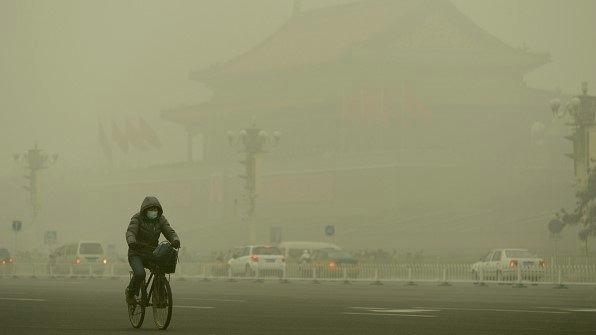- November 15, 2018
- Posted by: DAVID FRANCIS JOSE
- Category: CLIMATE CHANGE AND ENVIRONMENT, Featured, Latest Work, OPINION, POLLUTION & HAZARDS

The air we breathe is most often contaminated with the pollutants like Particulate Matter (ranges from a diameter of 2.5-10 micrometres), Carbon Monoxide (CO), Sulphur Dioxide (SO2), Nitrogen Dioxide (NO2) and Ozone (O3). These pollutants are harmful when it enters the human body due to prolonged exposure causing severe health issues; cancer, lung and brain damage and abnormalities in babies during pregnancy.
Air pollution has become a major global concern in recent years. The air quality starts to worsen since industrialization. Since the inception of automobile industries, the demand for petroleum saw a steep increase. The booming automobile and petroleum industries resulted in the exceptional economic growth of the nations. Unfortunately, the concerned governments ignored the aspect of environmental and health hazards and considered only the lucrative side of the industrialization and promoted it.
During the mid-twentieth century the episode of photochemical smog, formed as a reaction of oxides and particulate matter present in the atmosphere, in a few big cities, like Los Angeles, London, and New York City, causing allergies and asthma created large health concerns for the population.
The population across the world became aware of the impending issues and raised their concern; this provoked the environmentalist, health scientists, and other communities to pursue the policymakers to call for global actions to solve the problem. Nations together take some serious initiatives in partnership with other concerned organisations to control the emission. The Paris Agreement is one such initiative with collective global participation to control and appraise the factors contributing to its severity. One of the critical aspects of this agreement is to limit the global temperature increase to 2°C and down to 1.5°C soon after. By this agreement, India needs to produce an amount of energy equivalent to 40% of electric power capacity from non-fossil based energy resources by 2030.
Many developed countries implemented innovative ideas to curb pollution by reducing excess emissions and achieved slight improvements in environmental conditions. India as a fast developing nation should adopt and enforce better innovative ideas by importing concepts and techniques from other countries to reduce or eliminate pollution and implement them into every sector that is responsible for creating any source of air pollution. But it seems India almost lose this opportunity to build better and breathe clean.
In 1970 US President Nixon ordered and led to establishing an autonomous body to protect the environment called Environmental Protection Agency (EPA). EPA then recruited top scientists and engineers to study and find solutions to various environmental issues. In 2014 Supreme Court ordered the Indian Government to create an autonomous body similar to the EPA in the USA. There are efficient scientists, engineers, and environmentalists in India; the government should hire them to find a solution to pollution but it seems government diluted this direction.
There are laws in India to protect environment like The Environment (Protection) Act, 1986 and Air (Prevention and Control of Pollution) Act, 1981. These acts clearly state that Central government has the authority to make direct appointments of officers, who have the power to enter and inspect any industry whenever. The pollution Act states that “no person shall without the previous consent of the State Board, establish or operate any industrial plant in an air pollution control area” unless the industry was established “immediately before the commencement of section 9 of the Air (Prevention and Control of Pollution) Amendment Act, 1987. For which no consent was necessary before such commencement, may continue to do so for three months from such commencement or, if he has made an application for such consent within the said period of three months, till the disposal of such application”. So we need to think about why the governments are reluctant to act on this? Do they fear these large industries or favour them for their money and resources?
The government received funds from various sources like green taxes, cess, CSR funds from public/private sector organisations and global support in the form of GEF (Global Environment Facility), exclusively for environmental or green projects. When the reports of exceeding air pollution and ecological degradation coming from all the corners of the nation then also in the 2018 budget allocation, the environment sector was not given much significance. It seems the government is not interested in investing or spending on critical environment needs.
Recently Delhi; the national capital is branded as one of the most polluted cities in the world with AQI recorded more than 500 in many areas. The main reasons behind the pollution in Delhi are emission from industries, dust from construction sites, stubble burning in farms of neighbouring states. Farmers follow the stubble burning because it is cheap and easy. Solution to this is to provide the required assistance or machines for the farmers to clear the stubble properly. But the state and central governments are neither interested in removing the political deadlock nor does implementing the ban as farmers represent the majority of voters, and nobody wants to upset them.
Indian states should implement a few things on an urgent basis to minimize the present state of air pollution. The number of cars in cities proliferates every year leading to more pollution. The governments can encourage people to use transportation services by reducing the charges as public service is not meant for profit-making. With improved and better public transit systems people could benefit from it. The governments should also implement one car (running on diesel and petrol) per family rule.
The governments should replace the city buses running on diesel with electric buses and encourage the electric vehicle industry by providing tax deductions; there are few innovative EV start-ups in India. The governments should support these companies and encourage people to use their products by offering subsidies. Likewise, dedicate the significant part of streets to walkways and bicycle lanes instead of automobiles like Amsterdam.
Public places like transit stations are one of the places where most pollutant particulates accumulate, so providing proper filters and enclosing the area if possible could eliminate serious health issues.
The other major contributors to pollution are coal industries and construction sites. The coal industries continuously produce some toxic pollutants like lead, mercury, sulphur dioxide, Particulate Matter and other dust particles. The construction sector provides a considerable amount of dust and particulate matter. The government has failed to take serious action against these industries. The government should supplant government coal power plants with solar or wind and take measures against the present industrial practices by imposing fines and high carbon price for this industrial emissions.
In my opinion, a few examples in the world that when, wholly or partially, adopted and introduced to India in the future can reduce or control pollution are:
Construction of buildings is a requirement in city development. Ordinary cement increases the heat which acts as a catalyst for pollution. The photocatalytic concrete (smog-eating concrete) developed by an Italian cement manufacturer Italcementi helps in reducing pollution by 20%-70% depending on the pollutants. Construction companies in Italy started using this cement. An example is the building Palazzo Italia in Milan.
In Singapore, they took it to an innovative phase by covering large buildings with beautiful vertical gardens, which not only makes the cities attractive like the “hanging garden” but a perfect ecosystem free from pollution to work and live. Singapore is covering itself in more plants than any cities, and hence it is often known as the greenest city in Asia. Examples of these are ‘Parkroyal’ hotel and ‘Oasia’ hotel in Singapore.
Beijing, China saw one of the worst smog in 2018, and since then China seeks to reduce or control pollution and heat. As a part of this, China is planning to build some ventilation corridors. This ventilation corridor uses wind characteristics from the system, which consists of parks, suburbs, water bodies, to mitigate urban heating and pollution.
Another approach from China is to utilize its large skyscrapers to filter the smog. China uses large vacuum cleaners installed at the top of the buildings to purify the air. It sucks the air surrounding the filter from 360odirection utilizing a laser to detect it and ejects the filtered air. The pollutants collected in powdered form will have carbon components which are utilized to create small jewellery. Small sensors are installed at the various location in the cities which can function as a network to accumulate the pollution patterns and use the data for further research.
India receives enough funds but that amount was not effectively utilized for finding solutions for the pressing environmental and pollution issues. Even though there are laws and regulations regarding limiting emissions from industries the government is not keen to act on mala fide practices. It’s a high time for India to start productive investments in this sector as it can lead to a public health and environmental crisis. We can hope when the new and existing innovations are collectively put together, it may give the best result in tackling pollution.
India is a country with many differences in culture, language, practices but when it comes to environment and ecosystem, it affects everybody equally. So as the citizens we do have some responsibilities. We should try to reduce the use and consumption of products that cause environmental problems. If we need a healthy and advanced future we the citizens need to stand in solidarity to act and demand what is rightfully ours. It’s time to think what we need, a 3000 core statue or better living conditions.

